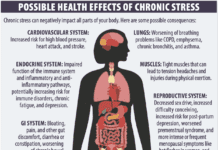Healthy Lifestyle May Outweigh a Genetic Risk Factor for Heart Disease
Abdominal obesity (a waist circumference of more than 35 inches in women and 40 inches in men) is a well-established risk factor for coronary heart disease (CHD), the leading cause of death and disability in the United States. Scientists have found genetic markers associated with elevated risk for developing abdominal obesity. But genetic susceptibility may not doom an individual to higher CHD risk.
A large observational study assessed the genetic risk for abdominal obesity (measured by waist-to-hip ratio) for 280,000 British participants. They also looked at participants’ adherence to five healthy lifestyle factors: getting regular physical activity, not currently smoking, consuming a healthy dietary pattern, drinking alcohol less than three times a week, and getting seven to nine hours of sleep a day. They then looked for instances of CHD over an average of almost 14 years of follow-up. They found that, on average, individuals who had high or medium genetic risk of abdominal obesity but adhered to a healthy lifestyle had a lower risk of developing CHD, compared with those who had low genetic risk and an unhealthy lifestyle.
Genes are not always the end-all when it comes to health. Lifestyle choices are powerful—for better or for worse.
Gastrointestinal Side Effects from Popular Weight Loss Drugs are Rare, but Real

Glucagon-like peptide 1 (GLP-1) receptor agonists have been used for decades to treat type 2 diabetes and are now being used for weight loss (see December 2023 issue). It is known that these medications increase risk for gastrointestinal adverse events in patients with type 2 diabetes, but the newness of their use in people without diabetes means we have little data on side effects in that population.
In a study published after our December issue was written, researchers looked at a random sample of 16 million people with obesity but not diabetes who were prescribed a GLP-1 receptor agonist or the drug bupropionnaltrexone, a weight loss drug that is not a GLP-1 agonist. Incidence of gallbladder or bile duct (biliary) disease, inflammation of the pancreas (pancreatitis), bowel obstruction, or gastroparesis (slow stomach emptying) were recorded.
Compared to the bupropion-naltrexone, use of GLP-1 agonists was associated with higher risk of pancreatitis, bowel obstruction, and gastroparesis, but not biliary disease. These adverse events were extremely rare. For example, the risk of developing pancreatitis when taking the GLP-1 agonist semaglutide (the active ingredient in Wegovy and Ozempic) was 4.6 per 1,000 person-years, compared to 1.0 for users of bupropion-naltrexone. Pancreatitis risk in individuals taking liraglutide (the GLP-1 agonist that is the active ingredient in the diabetes drugs Victoza and Saxenda) was 7.9 per 1000 person-years.
While risk is low, people considering taking GLP-1 agonists for weight loss should discuss the risks and options with their healthcare provider before deciding to use these drugs.
Red Meat Intake Associated with Risk for Type 2 Diabetes
 Current dietary guidelines recommend limiting intake of red meats (beef, pork, and lamb), primarily due to their content of saturated fat, which increases risk for heart disease. The results of a comprehensive new study suggest another reason to limit red meat intake—risk for type 2 diabetes.
Current dietary guidelines recommend limiting intake of red meats (beef, pork, and lamb), primarily due to their content of saturated fat, which increases risk for heart disease. The results of a comprehensive new study suggest another reason to limit red meat intake—risk for type 2 diabetes.
The study gathered frequency of red meat intake from over 200,000 U.S. adults and documented type 2 diabetes cases in over two decades of follow-up. Higher intake of red meat, whether processed (like bacon, sausage, and deli meats) or unprocessed (like hamburger and steak), was associated with higher risk of developing type 2 diabetes. In general, the more red meat people ate, the higher their risk. Participants who ate the most total red meat had a 62 percent higher risk of developing the disease. (Importantly, these individuals also had poorer diet quality overall and were less likely to be physically active, which likely contributed to their increased risk.) Swapping a serving of red meat for a serving of dairy was also associated with lower risk. [Editor’s note: There are concerns about some components of full fat dairy increasing diabetes risk, so fat free and low-fat dairy products are best choices.]
This study adds to a large pool of information suggesting swapping red meat of all kinds for other protein choices (like poultry and dairy, but especially plant proteins like legumes) is a healthy choice.
























